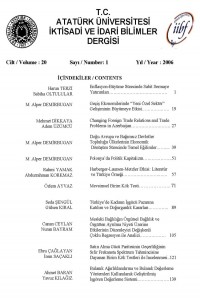BULANIK AĞIRLIKLANDIRMA VE BULANIK DEĞERLEME YÖNTEMLERİ KULLANILARAK GELİŞTİRİLMİŞ İŞGÖREN DEĞERLEME SİSTEMİ
Öz
Bu çalışmada bulanık ağırlıklandırma ve bulanık değerleme
yöntemleri kullanılarak bir işgören değerleme sistemi geliştirilmiştir. Hem
işyerleri hem de işgören için oldukça önemli olan performans değerleme
işleminde kullanılacak bu sistemle yöneticiler, ölçütlere göre işgöreni hem
sayısal hem de sözsel değerlerme notları ile değerleyebilmektedir. Sistemde,
değerleme yapılacak işgörenin pozisyonuna göre, değerlemede farklı ölçütler
kullanılabilmekte ve kullanılan bu ölçütlerin değerlemedeki ağırlıkları
değiştirilebilmektedir. Sistem, objektiviteyi artırmak üzere, aynı işgören için
birden fazla yöneticinin görüşünü almakta ve ilk havuzlama tekniği ile
birleştirmektedir. Değerleme işlemini en büyük küme ve en küçük küme
yöntemi ile yapan sistem, Borland Delphi programlama dili kullanılarak
geliştirilmiştir.
Anahtar Kelimeler
İşgören değerleme Bulanık ağırlıklandırma Bulanık Dereceleme.
Kaynakça
- Aşkun, İ.C. (1982), İşgören, Bayteş Yayıncılık, İstanbul.
- Bingöl, D. (1997), Personel Yönetimi, Üçüncü Baskı, Beta Yayınevi, İstanbul.
- Buckley, J.J. (1985) “Ranking alternatives using fuzzy numbers”, Fuzzy Sets and Systems, 15, ss. 21-31.
- Chen, S.H. (1985) “Ranking fuzzy numbers with maximizing set and minimizing set”, Fuzzy Sets and Systems, 17, ss.113 129.
- Chen, S.J. ve Hwang, C.L. (1992) “Fuzzy multiple attribute decision making methods and applications”, Lecture Notes in Economics and Mathematical Systems, ss. 5 13.
- Chen,C. ve Klein, C.M. (1997) “An efficient approach to solving fuzzy MADM problems”, Fuzzy Sets and Systems, 88, ss.51 67.
- Dicle, Ü. (1982) “Yönetsel Başarının Değerlendirilmesi Türkiye Uygulaması”,ODTU İ.B.F. ss. 38 53.
- Dubois, D. ve Prade, H. (1980) “Ranking of fuzzy numbers in the setting of possibility theory”, Inform. Sci., 30, ss.183 224.
- Lee, E.S. ve Li, R.L. (1988) “Comparison of fuzzy numbers based on the probability measure of fuzzy events”, Computers and Mathematics with Applications, 15, SS.887 896.
- Raj, P.A. ve Kumar, D.N. (1999) “Ranking alternatives with fuzzy weights using maximizing set and minimizing set”, Fuzzy Sets and Systems, 105, ss.365 375.
- Randle, W. ve Monroe, W. (1961) “Better Ways to Measure Executive Performance”, Management Methods, 19(4), ss. 64 66.
- Ribeiro, R.A. (1996) “Fuzzy multiple attribute decision making: A review and new preference elicitation techniques”, Fuzzy Sets and Systems, 78,ss.155 181.
- Timur, H. (1983) “Personel Başarı Değerlendirilmesi ve Türki Adli Yargı Örneği”, TODAİE Dergisi, 16(3), ss. 7 14.
- Zimmermann, H.J. (1987), Fuzzy Set, Decision Making and Expert System, Kluwer, Boston.
Öz
Kaynakça
- Aşkun, İ.C. (1982), İşgören, Bayteş Yayıncılık, İstanbul.
- Bingöl, D. (1997), Personel Yönetimi, Üçüncü Baskı, Beta Yayınevi, İstanbul.
- Buckley, J.J. (1985) “Ranking alternatives using fuzzy numbers”, Fuzzy Sets and Systems, 15, ss. 21-31.
- Chen, S.H. (1985) “Ranking fuzzy numbers with maximizing set and minimizing set”, Fuzzy Sets and Systems, 17, ss.113 129.
- Chen, S.J. ve Hwang, C.L. (1992) “Fuzzy multiple attribute decision making methods and applications”, Lecture Notes in Economics and Mathematical Systems, ss. 5 13.
- Chen,C. ve Klein, C.M. (1997) “An efficient approach to solving fuzzy MADM problems”, Fuzzy Sets and Systems, 88, ss.51 67.
- Dicle, Ü. (1982) “Yönetsel Başarının Değerlendirilmesi Türkiye Uygulaması”,ODTU İ.B.F. ss. 38 53.
- Dubois, D. ve Prade, H. (1980) “Ranking of fuzzy numbers in the setting of possibility theory”, Inform. Sci., 30, ss.183 224.
- Lee, E.S. ve Li, R.L. (1988) “Comparison of fuzzy numbers based on the probability measure of fuzzy events”, Computers and Mathematics with Applications, 15, SS.887 896.
- Raj, P.A. ve Kumar, D.N. (1999) “Ranking alternatives with fuzzy weights using maximizing set and minimizing set”, Fuzzy Sets and Systems, 105, ss.365 375.
- Randle, W. ve Monroe, W. (1961) “Better Ways to Measure Executive Performance”, Management Methods, 19(4), ss. 64 66.
- Ribeiro, R.A. (1996) “Fuzzy multiple attribute decision making: A review and new preference elicitation techniques”, Fuzzy Sets and Systems, 78,ss.155 181.
- Timur, H. (1983) “Personel Başarı Değerlendirilmesi ve Türki Adli Yargı Örneği”, TODAİE Dergisi, 16(3), ss. 7 14.
- Zimmermann, H.J. (1987), Fuzzy Set, Decision Making and Expert System, Kluwer, Boston.
Ayrıntılar
| Birincil Dil | tr;en |
|---|---|
| Bölüm | Makaleler |
| Yazarlar | |
| Yayımlanma Tarihi | 27 Kasım 2010 |
| Yayımlandığı Sayı | Yıl 2006 Cilt: 20 Sayı: 1 |





